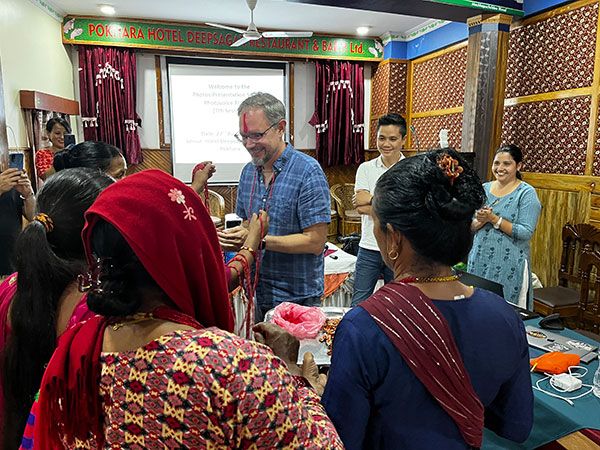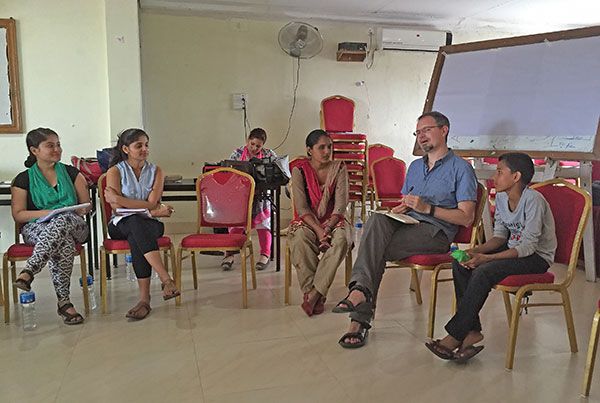
and staff in rural primary care clinics.
Nepal, a south Asian nation half the size of the state of Arizona, has seen an outsized number of challenges. Between 1996 and 2006, thousands of child soldiers were conscripted into a civil war that took the lives of more than 17,000 people and displaced 200,000 Nepalis. Perched on the intersection of two tectonic plates, the country is especially vulnerable to earthquakes — including two catastrophic temblors in 2015 — as well as to floods and other extreme weather events. Each crisis brings with it mental health challenges for the people living there — people who Brandon Kohrt, MD, PhD, director of the Center for Global Mental Health Equity at the George Washington University (GW) School of Medicine and Health Sciences (SMHS), has been working with for more than 25 years.
His time in Nepal — both in the wake of humanitarian crises and alongside people in their daily lives — has sparked the development of mental health programs around the world, funded by agencies from the World Health Organization to the National Institute of Mental Health. Wherever Kohrt goes, his efforts focus on training community members to provide mental health care, offering support that relies on local culture and an intimate understanding of what people need to heal.
This approach emerged from Kohrt’s longstanding commitment to Nepal, starting as an undergraduate, when he spent a year learning how traditional healing informed mental health practices, particularly in areas with limited access to conventional psychological or psychiatric care. A psychiatrist and anthropologist by training, Kohrt returned to Nepal for his doctoral research, working with childhood soldiers returning to their communities after the country’s decade-long civil war.

The experience of getting to know the language, the people, and the setting over many years made him realize that “it really requires long-term investment to learn and to be able to contribute,” says Kohrt, GW’s Charles and Sonia Akman Professor of Global Psychiatry at GW SMHS. Through that long-term investment, he’s found that a critical part of mental health care — in places from Haiti to South Africa to New York City — involves the people who have the most important investment of all: the community members themselves.
Kohrt has worked to create programs offering local training, supervision, and support from professional mental health workers to allow people from many walks of life to provide on-the-ground care. In Nepal, his trainees include female community health workers who volunteer to serve the community, and staff in rural primary care clinics. Both groups provide support that is much easier to access than the larger urban health care centers which may be several mountain passes away.
This grassroots approach to mental health care caught the attention of the Carter Center’s Mental Health Program, founded by former First Lady Rosalynn Carter. Kohrt began collaborating with the Carter Center in 2010 as they launched a new mental health program in Liberia — addressing the aftermath of Liberia’s civil war, as well as the stigma and discrimination surrounding mental illness.
Leaning on his anthropology background, Kohrt builds a set of best practices in each region based on the local cultural concepts of mental health, as well as who might be the best people to intervene early in mental health. In Liberia, law enforcement officers were most likely to be the first line of contact with those in acute crisis — and they needed training to connect people with the help they needed.
Kohrt found that being trained to help others also gave these officers an opportunity to talk about their own mental health. “A lot of them had [post-traumatic stress disorder] from the years of conflict and daily exposure to violence.”

Through this approach, Kohrt and his colleagues have seen major reductions in suicide attempts in prisons, less use of force against people with mental health conditions, and lower injuries to both officers and those with mental health conditions. He’s led multiple efforts to bring local people into mental health care teams globally and locally. In response to the COVID-19 pandemic, Kohrt and colleagues, including Adam Brown, PhD, and Manaswi Sangraula, PhD, BS ’12, assistant research professor with the GW Center for Global Mental Health Equity in the GW SMHS Department of Psychiatry and Behavioral Health, began adapting a program called Problem Management Plus, previously implemented in Nepal, as an online training for mental health care workers in New York City, with a focus on community organizations serving Black and brown New Yorkers.
In Nepal, Kohrt and his colleagues Sauharda Rai, PhD, at the GW Center for Global Mental Health Equity, and Dristy Gurung, at Transcultural Psychosocial Organization Nepal, also developed a program aimed at reducing mental health stigma. Community members who experience mental health issues receive training in basic photography; the group spends up to three months creating images of life with anxiety, depression, psychosis, or substance use conditions. Then they give presentations about their experiences with mental health, treatment, and recovery to health care workers and the wider community. “Often we find this approach leads to primary care workers making better diagnoses, because they’re actually thinking about people and stories as opposed to thinking in terms of clinical checklists,” Kohrt says. “That type of training and storytelling can both be more effective at reducing stigma and also lead to better clinical care.”
In Uganda, Kohrt and Rai recently joined Byamah Mutamba, MD, PhD, a psychiatrist in Kampala, to launch a clinical trial of a similar photography-based program focusing on people living with psychosis. Kohrt says that people with relatively common mental health issues, such as depression or anxiety, are more often a part of collaborative efforts to develop programs that will best support them. “The point of our program in Uganda is that people with lived experience of psychosis should be part of the whole creation process, and even as partners in training health workers and in the delivery of services,” he says.

During a session for government officials, Kohrt says, the photographs and presentations from people living with psychosis and their families spurred one of health ministry leaders to share his own experience of parenting a child with a mental health condition. The official then threw his support behind making medications readily available, a huge local problem. “It’s just really interesting, the power of these narratives and these stories to really not only change what a health worker does, but also even policymakers can change their attitudes as well,” Kohrt says.
Initially, Kohrt thought of his approach as a stopgap; eventually, there would be more academically trained psychologists and psychiatrists, and the community-based approach wouldn’t be needed. And many, including Kohrt himself, wondered how effective non-professionals who’d received mere weeks of training could be. So he and his colleagues developed an extensive process to observe trainees to ensure they were providing support with empathy and safety in mind. In 2018, they worked with the World Health Organization and UNICEF to create EQUIP (Ensuring Quality in Psychological Support), a resource package including a digital platform that allows governments and NGO supervisors help their trainees develop the skills they need in any language, culture, or cultural context.
Kohrt now believes that even with ample professional mental health care, “these community-based services are integral to an overall functioning mental health system.” Along with providing immediate emergency support during a crisis — as the people he’d trained did following the 2015 earthquake in Nepal — community mental health also offers a safety net when the eyes of the world shift to another crisis. “The better that our mental health services are on a day-to-day basis, the more resilient communities will be to economic shocks, war, natural disasters, climate change, and pandemics,” he says.



